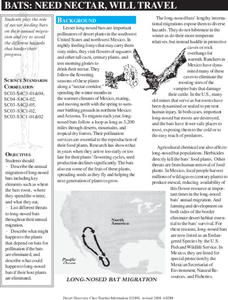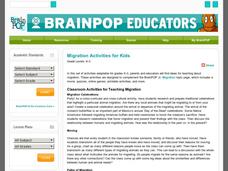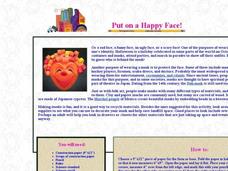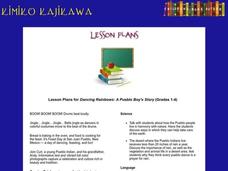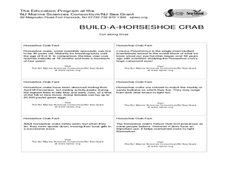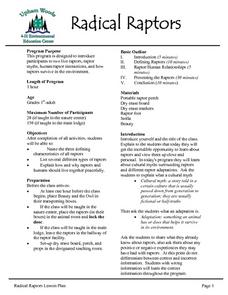Curated OER
Native American Three Sisters Gardens
Students investigate companion planting. In this communtiy gardening lesson students explore the tradition of the Native American Three Sisters gardening approach. Students act as botanists, anthropologists, folklorists, and curators.
American Museum of Natural History
Tornadoes Spinning Thunderstorms
Tornado winds can reach more than 200 miles per hour. Learners explore wind speeds and more characteristics of tornadoes with an online lesson. They learn how tornadoes form and how scientists attempt to predict them. Can be used as an...
Curated OER
Bats: Need Nectar, Will Travel
Beginning wildlife biologists become adult bats, baby bats, snakes, owls, bobcats, or land-clearing developers in a grand role-playing activity. In a large open space, they play a game in which they move to designated areas based on what...
BrainPOP
Migration Activities for Kids
For as long as there has been life on earth, animals, including humans, have used migration as a means of survival. This collection of activities supports young scientists as they learn about this behavioral adaptation, encouraging them...
Curated OER
The Gulf Oil Disaster
High schoolers take a closer look at the Gulf oil spill of 2010. In this global issues instructional activity, students analyze political cartoons related to the crisis. High schoolers discuss their impressions of the crisis and U.S....
Curated OER
Great Balls of Fire
Sixth graders compare and contrast natural and synthetic fabrics. In this science investigation lesson, 6th graders test the flammability of 6 natural and synthetic fabrics.
Curated OER
The Day the Water Ran Out
Students explore ecosystems by researching desert characteristics. In this drought activity, students identify the potential impacts of a drought on their home state and interview people who are familiar with water studies. Students...
Curated OER
A Tough Nut to Crack
Children, based on a set of criteria, evaluate the quality of pecans. They research recorded history of pecan trees as well as how their seeds moved across western Missouri into southeastern Kansas, Oklahoma, Texas and Mexico. In...
Curated OER
Drought Threatens Huge Man-Made Lake
Students locate Lake Mead, then read a news article about Lake Mead drying up and how that would effect water and power supplies to the region. In this current events lesson, the teacher introduces the article with a map and vocabulary...
Curated OER
Uses of Minerals
In this minerals worksheet, students read an excerpt about gold and then respond to the questions that follow. They explain how the weight of gold affected the history of some western states and why gold is expensive.
Curated OER
Put on a Happy Face!
Students explore using recycled materials. For this ecology/art lesson, students use recycled materials to create a Halloween mask. Students view folk art made of natural and available resources, and discuss possible cultural uses for...
Curated OER
Dancing Rainbows: A Pueblo Boy's Story
Students read the book "Dancing Rainbows," and complete a variety of activities across the curriculum. In this Native Americans lesson plan, students create pottery, discuss Pueblo traditions, discuss the importance of rain, and learn...
Curated OER
Clothesline Sleuth
Students explore the make up of fabrics. In this agriculture lesson, students examine the cotton and wool crops of the United States and discover how fabrics are created.
Curated OER
Build-A-Horseshoe Crab
Students discover many facts about horseshoe crabs. Students identify the main body parts of horseshoe crab. They explore the habits of the horseshoe crab and their importances to the ecosystem. Adaptations for younger students are...
Curated OER
Radical Raptors
Students are introduced to raptors and their role in the environment. They identify three characteristics of raptors and list several types of raptors found in nature. They discuss their positive and negative experiences with raptors and...
Curated OER
Bats
Pupils examine the migration patterns of the long-nosed bat. They identify threats to the animal and the plants bats help pollinate. They participate in a game to help them with the information.
Curated OER
A Tough Nut to Crack
Students study the origins and background of the pecan. For this agriculture lesson students divide into groups, complete an activity and worksheets.
Curated OER
SEEDS WE EAT
Students identify seeds humans eat and do not eat. Students make seed collections, using common kitchen foods. Students display seeds from the foods they serve and discuss them with their guests. Students complete activities which...
Curated OER
Assigning Roles: Becoming Advisors to Individual Nations and Assembling Country Profiles
Middle schoolers role play the role of advisors to countries on the issue of global warming. In their groups, they identify the main issues affecting their country along with any opposing viewpoints. They use the internet to research...
Curated OER
BATS: NEED NECTAR, WILL TRAVEL
Students play the role of nectar feeding bats on their annual migration
and try to avoid the different hazards that hinder their progress. They describe the annual migration of long-nosed bats including key elements such as: where the...


